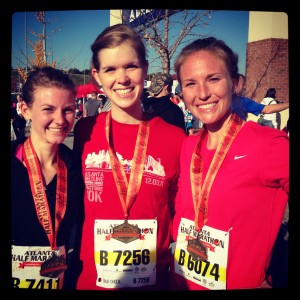The last two years have been big ones in running for me. In 2011, I ran my first half marathon (after never stepping a foot past a 10K) and in 2012, I racked up several new races, including a PR in the Thanksgiving Half Marathon of 1:49 (who knew that was possible). To say I’ve come a long way in my love for running in the last few years is a bit of an understatement, but as with any passion, it does have its gritty points.
I came across this article today from the December issue of Women’s Health titled “When Running Isn’t Healthy” and while I’ve fallen in love with running over the years, learning the difference between running smart and running a little too far is difficult to say the least.
James O’Keefe, MD, Director of Preventative Cardiology at the Saint Luke’s Mid America Heart Institute in Kansas City stresses the importance of balance, quoted saying, “Exercise may be the most important component of a healthy lifestyle, but like any powerful drug you’ve got to get the dose right.”
It’s a contradictory feeling, how could exercise be bad for me? I’ve learned the right dose is not easy (and it’s still something I’m figuring out). When I trained for my first half marathon, I procrastinated on training, meaning I had to squeeze jumps in milage in very quickly. I finished, but it left me very sore and taking a break of more than a week.
By my third half this November, I spent months in advance working milage up and down, practicing shorter runs on hills and longer runs at a much more steady pace by the river – and it paid off with a PR and playing football with the family the next day.

After crossing the finish line on Thanksgiving day – and PRing at 1:49 with two amazing running partners.
According to a recent study quoted in the article where researchers tracked over 52,000 people for 30 years, “runners had a 19 percent lower death risk than non-runners. However, the health benefits of exercise seemed to diminish among people who ran more than 20 miles a week, more than six days a week, or faster than eight miles an hour. The sweet spot appears to be five to 19 miles per week at a pace of six to seven miles per hour, spread throughout three or four sessions per week.” Source.
As much I want to run out the door and literally run for miles, I know that’s not responsible. I know my longer than average runs on weekends (for me that’s anything above about 6-7 miles) mean I have to slow down and enjoy my time outside.
You set records on race day, not on the grueling foggy, Saturday morning runs.
I’ve learned that if I don’t replenish my body with calories after a long run, I wind up with a migraine (bring on the carbs and cookies). As much as I would love to train for a marathon, I still have some work to do to figure out how to manage my challenge of maintaining a healthy weight while training.
Yesterday, I logged a cool 7.5 miles. I felt fantastic for the first time in weeks and to no surprise, my pace was 20 seconds slower than my average, just where it should be.
Are you an avid exerciser? What works best and what have you learned to stay away from?
*The thoughts included in this post represent my own personal experiences in running. If you are interested in getting started, check out a training schedule and stick to it, everyone’s body is different and will aclimate in different ways. Psst….one of my favorite training plans can be found here.



Pingback: I’ve hit a whole new level of {running} crazy | Blurring Edges | Blurring Edges